P3: Pressure problems and Moving the Ball
Page 3
Pressure Problems and Moving the Ball
On this page we look at the simple ways a player needs to move the ball around their body to solve a particular pressure problem. We wont go into footwork specifics yet, but will start on the premise that if the ball is position A and the players wants to move it to position B (say), what does the ball need to do?
In the pressure problems below please note that :
- The ball is always on the players right foot. [The left foot would work in the opposite way]
- The assumption is that the defender is always closing down the attacker with the intention of tackling and winning the ball.
- The black arrows in the illustrations show the direction the attacker is facing, and the direction the defender is moving.
- The Nutmeg is ignored as an option
- The problems are kept very simple initially. There is no deception, nor improvisation. There is no manipulation of the moment.
Face - On Pressure
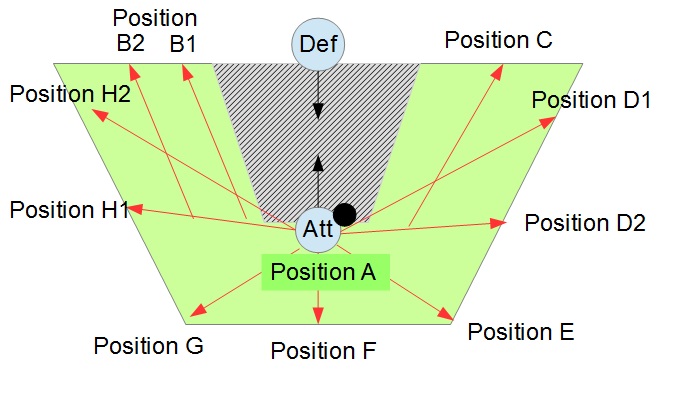
What needs to happen to the ball to get from position A, to another position?
[You don't need to read all the options, just understand that they exist]
| To get from position A to | Position B1 | the ball must be moved | across the body and then forward past the defender |
| Position B2 | across and out of the body and then forward past the defender | ||
| Position C | away from the body and then forward past the defender | ||
| Position D1 | diagonally away from the body to the forward diagonal lateral space | ||
| Position D2 | away from the body to the lateral space | ||
| Position E | diagonally away from the body to the diagonal lateral space behind | ||
| Position F | under the body to the space behind | ||
| Position G | under and away diagonally from the body to the diagonal lateral space behind | ||
| Position G | across and away diagonally from the body to the diagonal lateral space behind | ||
| Position H1 | across and away from the body to the lateral space | ||
| Position H2 | diagonally across and away from the body to the forward diagonal lateral space |
What about having the ball on the left foot?
Having the ball on the left foot in this scenario does not change anything in regards to where the ball needs to go relative to the attackers position. The only change is as follows:
- If the attackers wants to go right then the ball needs to be moved across the body
- If the attackers wants to go left then the ball does not need to be moved across the body
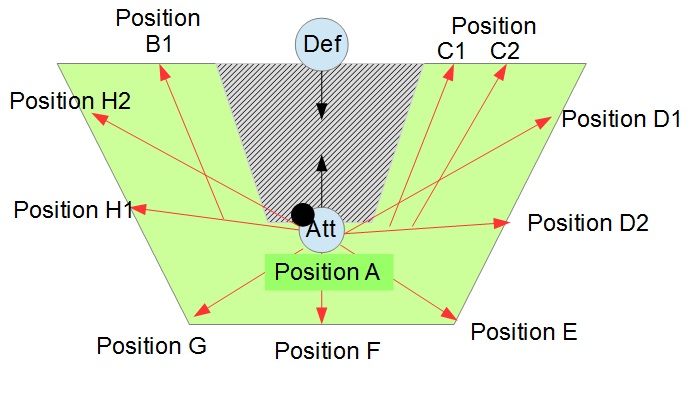
Angled Pressure

These are the only additional ways the ball needs to be moved.
| To get from position A to | Position B1 | the ball must be moved | forward past the defender |
| Position B3 | diagonally away from the defender |
What about having the ball on the left foot, when the pressure is coming from the left?
Having the ball on the left foot in this scenario changes the following;
- To get to the the right the ball would first need to be moved across the body.
- To get to the left the ball would not need to be moved across the body.
Note however , these are not new ways to move the ball around the body
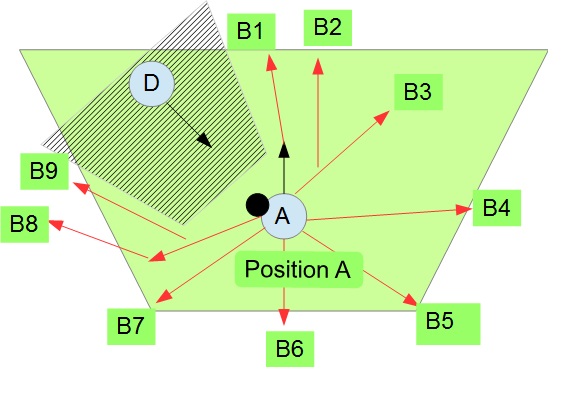
Side - On Pressure
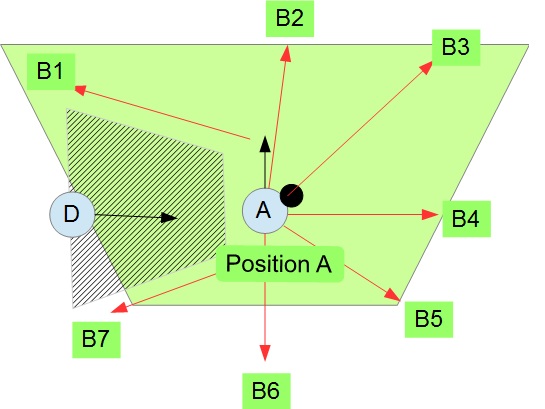
The only new directions the ball needs to move in this scenario involve getting the ball from position A to B1 and B7
| To get from position A to | Position B1 | the ball must be moved | forward and then laterally counter to the defenders direction of movement |
| Position B7 | Backward and then laterally counter to the defenders direction of movement |
What about having the ball on the left foot, when the pressure is coming from the left?
Having the ball on the left foot in this scenario does not change the direction the ball needs to be moved. However it may change how the ball is moved when trying to get to a position. This will be looked at when we get into the footwork specifics.
Note, if the attacker wants to get to positions on the right the ball would need to be moved across the body first.
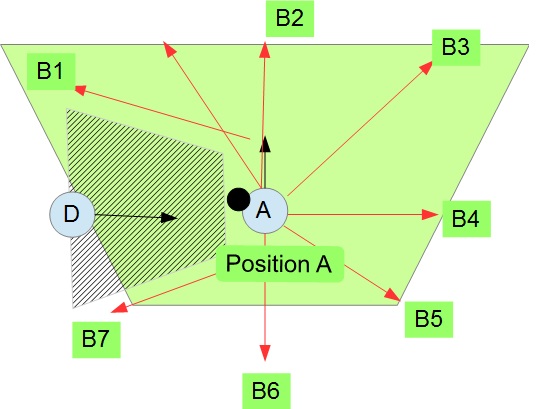
Along-Side Pressure
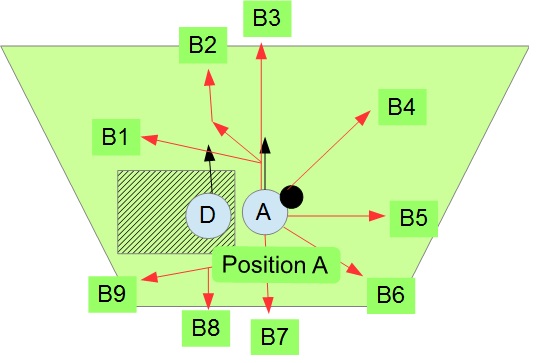
Along side pressure problems assume both the attacker and defender are moving in the same direction, side by side.
- This scenario opens up the option for turns. So getting to position B7 (and even B6 ) would involve a full 180 degree change of direction.
- In along side pressure it is assumed that the defender is right next to the defender so that the attacker cant turn and face the defender, and must be conscious of protecting the ball during a turn.
- Along side pressure can also get a bit more complicated depending on exactly where the pressure is.
- Positions B2 and B8 might be used when the defender is very slightly behind and it is possible to maneuver into the defenders path (blocking his running line). otherwise there are no new ways to maneuver the ball around the feet/body to get to one of the other positions.
| To get from position A to | Position B2 | the ball must be moved | forward lateral Forward to get in front of the defender |
| B7 / B6 | Stopped and turned around (turn) | ||
| Position B8 | Stopped and turned around and then moved in line of the defender |
What about having the ball on the left foot, when the pressure is on the left?
Having the ball on the left foot changes the options a little :
- If the attacker wants to get to positions on the right the ball would need to be moved across the body first.
- If the attacker wants to turn then if the defender was close there would be a risk of turning into the pressure, so it would be wise to only have the ball on the defenders side if there was space between the attacker and defender (so protecting the ball is not an issue).
- If the defender was not directly next to the attacker, then getting to the options on the left would be hard. But then again, if the defender gave the attacker the space then the attacker could turn and face the defender 9that is; change the pressure problem).
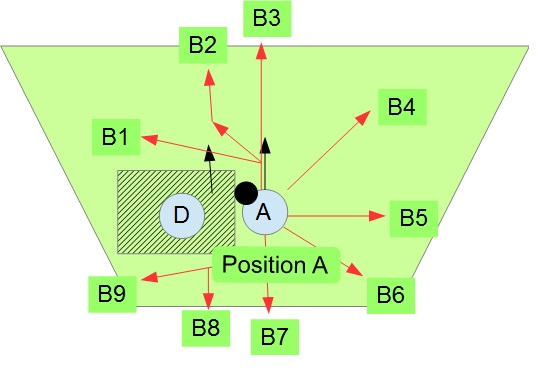
Pressure Behind
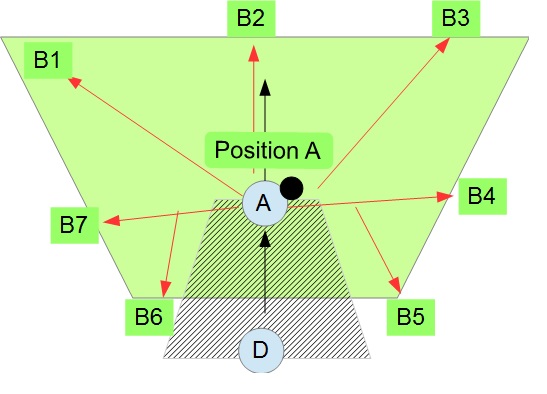
The only new directions the ball needs to move in this scenario involve getting the ball from position A to B5 and B6
| To get from position A to | Position B5 | the ball must be moved | away from the body and then backwards past the defender |
| Position B6 | across the body and then backward past the defender |
What about having the ball on the left foot?
Having the ball on the left foot in this scenario does not change anything in regards to where the ball needs to go relative to the attackers position. The only change is as follows:
- If the attackers wants to go right then the ball needs to be moved across the body
- If the attackers wants to go left then the ball does not need to be moved across the body
Moving the Ball
If we now just focus on the directional ways the ball can be moved, the above can be boiled down to the following:
[You don't need to read all the options, just understand that the above boils down to this list]
| away from the body and then forward into the lateral forward space |
| diagonally away from the body and then forward into the lateral forward space |
| diagonally away from the body to the diagonal lateral space |
| away from the body to the lateral space |
| diagonally away from the body to the behind diagonal lateral space |
| under the body to the space directly behind |
| turn to the space directly behind |
| diagonally under the body and then away from the body to the diagonal lateral space behind |
| across the body and then away diagonally from the body to the diagonal lateral space behind |
| across and away from the body to the lateral space |
| diagonally forward across and away from the body |
| diagonally forward across and out of the body and then forward |
| across and out of the body and then forward |
| across the body and then forward |
| directly forward (unopposed forward movement) |
| forward, laterally across the body, Forward (a quick change of lanes) |
| forward then across the body laterally (90 degree change of direction) |
| Backward and lateral across the body (90 degree change of direction) |
| Backward, lateral across the body, forward ( a quick change of lanes) |
On the next page we will try to look at what all this means in a practical sense.
That is ; what does moving the ball ' away from the body and then forward ' actually look like.
When looking at these we will try to find the simplest method available to do the job. This will then start directing us to the:
Fundamental Footwork patterns
***
Next Page P4 :
Ball moving and Footwork Patterns